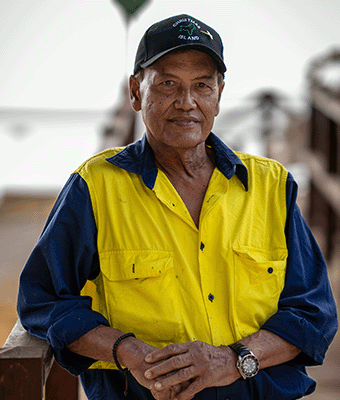Christmas Island Sampan
With no native population on Christmas Island when it was discovered, it was a blank canvas culturally when the first settlement was formed at Flying Fish Cove in 1888.
Amalgamating European, Chinese, Malay and other influences from its migrant workforce, Christmas Island soon established its own unique cultural traditions that have endured to this day.
Emblematic of this shared culture is the Christmas Island canoe, known locally as a sampan or kolek.
Brought to Christmas Island from Ambon Island in Indonesia, the dug-out sampan was embraced by Christmas Island locals as an ideal fishing and recreation vessel in the early 1900s.
Carved from the trunks of soft-wood trees close to shore, the sampan became so ubiquitous on Christmas Island that it was commemorated on a Christmas Island postage stamp in 1990.
Today, the once ever-present sampan is entirely absent from the fleet of recreational vessels that depart Christmas Island to fish its abundant waters.
There are several reasons why sampans disappeared from Christmas Island: rubber or metal dinghies offered more durable alternatives and the introduction of commercial fishing licences meant fresh fish could be purchased instead of caught.
But the real tipping point for the Christmas Island sampan was the establishment and extension of the Christmas Island National Park to encompass the habitat of the tree the sampan was made from.
Even the most well-crafted sampan will only last a few years of frequent use, so without access to the Gyrocarpus americanus tree, the beloved vessel faded from sight.
While no Christmas Island residents would minimise the importance of the national park to protect its world-renowned natural assets, its existence has put something no less precious at risk of extinction: the knowledge of how to make the traditional sampan.
Of the expert craftspeople who chipped away at the trunk of a tree to form the sampan in generations past, only Fadal Maswari remains.
Fadal, 75 , learned the art of the sampan directly from Salleh Omardin, the progenitor of the Christmas Island sampan and is determined to preserve this knowledge for future generations.
By a twist of fate, Fadal had an opportunity to briefly revive the sampan on Christmas Island in 2014, when a cyclone felled a sampan-friendly tree near Ethel Beach.
For the first time in the 21st century, Flying Fish Cove heard the sound of a sampan being constructed, with three of the traditional vessels completed at the time.
While the construction attracted interest, it being an unplanned project meant Fadal wasn’t able to fully pass on his knowledge at the time.
But now, Fadal has received permission from the government to fell a tree within the national park to document and record the process of creating a sampan for future generations to access.
It starts with choosing the right tree.
While it’s hard to distil picking a tree into writing, Fadal says the most important thing is accessibility. It can be the best tree in the world, but once you chop it down, it has to be carried out of the forest to be carved into a sampan.
Once the tree is selected, an important step needs to be taken before the first swing of the axe: blessing the tree’s spirits and asking for permission to cut it down.
With this done, the tree is felled with a combination of axe strokes and chainsaws, carefully carried out to ensure it falls in a way that causes the least impact on surrounding trees.
The trunk of the tree is then measured and marked to indicate how many sampan it will produce and how many seats.
Fadal supervises every step of the process, with fellow Christmas Island locals Azmi, Roslan, Othman and Bahari lending a hand and absorbing as much of Fadal’s wisdom as they can.
The trunk is brought down to Flying Fish Cove for crafting, with the whole community gathered around to watch.
Where the sampan used to be carved entirely by hand, power tools like a chainsaw and a belt sander speed up the process significantly.
Even still, it is a painstaking process. But with each strike of the axe and whir of the chainsaw, a sampan slowly emerges from the trunk.
First, the layer of bark is removed, then the underside of the sampan is shaped, before the trunk is flipped over and the inside is hollowed out.
Everything from the depth of the cuts to the size of the outriggers is performed to Fadal’s specifications, just as he learned in his youth.
The last step is to paint the sampan – this iteration features a bright white interior with red, yellow and green stripes along the hull.
In true Christmas Island fashion, the completed sampan will be made available for any in the community who want to reconnect with the way previous generations harvested the bounty of the sea.
More than a simple fishing boat, Fadal sees the sampan as a symbol of the community’s connection to Christmas Island’s marine environment.
It’s uncertain when another opportunity to make a sampan will present itself, but by carefully documenting each step of this process, Fadal hopes he has preserved enough knowledge for future generations to launch sampans of Christmas Island for years to come.


